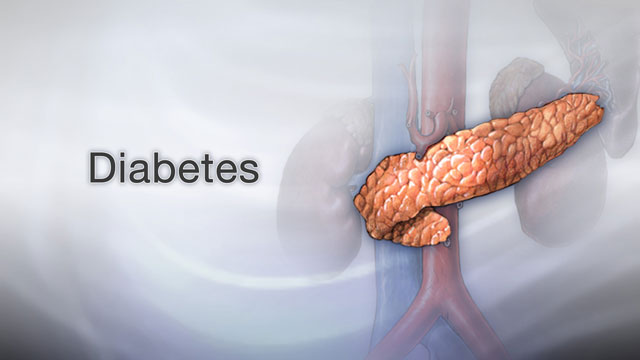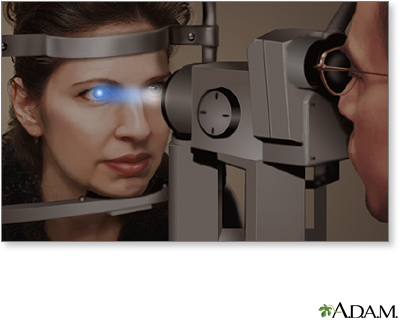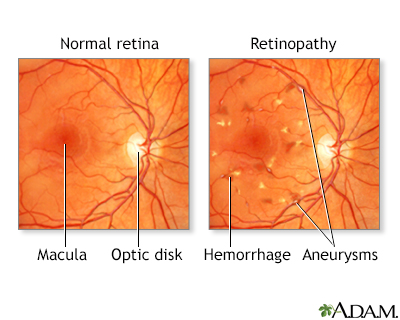Diabetes and eye disease
Diabetes can harm the eyes. It can damage the small blood vessels in the retina, the back part of your eye. This condition is called diabetic retinopathy.
Diabetes also increases the chance of having glaucoma, cataracts, and other eye problems.
Diabetes
Diabetes is a long-term (chronic) disease in which the body cannot regulate the amount of sugar in the blood.

Glaucoma
Glaucoma is a group of eye conditions that can damage the optic nerve. This nerve sends the images you see to your brain. Most often, optic nerve da...

Diabetes - Animation
Diabetes is on the rise worldwide, and is a serious, lifelong disease that can lead to heart disease, stroke, and lasting nerve, eye and foot problems. Let's talk about diabetes and the difference between the three types of diabetes. So, what exactly is diabetes and where does it come from? An organ in your body called the pancreas produces insulin, a hormone that controls the levels of your blood sugar. When you have too little insulin in your body, or when insulin doesn't work right in your body, you can have diabetes, the condition where you have abnormally high glucose or sugar levels in your blood. Normally when you eat food, glucose enters your bloodstream. Glucose is your body's source of fuel. Your pancreas makes insulin to move glucose from your bloodstream into muscle, fat, and liver cells, where your body turns it into energy. People with diabetes have too much blood sugar because their body cannot move glucose into fat, liver, and muscle cells to be changed into and stored for energy. There are three major types of diabetes. Type 1 diabetes happens when the body makes little or no insulin. It usually is diagnosed in children, teens, or young adults. But about 80% of people with diabetes have what's called Type 2 diabetes. This disease often occurs in middle adulthood, but young adults, teens, and now even children are now being diagnosed with it linked to high obesity rates. In Type 2 diabetes, your fat, liver, and muscle cells do not respond to insulin appropriately. Another type of diabetes is called gestational diabetes. It's when high blood sugar develops during pregnancy in a woman who had not had diabetes beforehand. Gestational diabetes usually goes away after the baby is born. But, still pay attention. These women are at a higher risk of type 2 diabetes over the next 5 years without a change in lifestyle. If you doctor suspects you have diabetes, you will probably have a hemoglobin A1c test. This is an average of your blood sugar levels over 3 months. You have pre-diabetes if your A1c is 5.7% to 6.4%. Anything at 6.5% or higher indicates you have diabetes. Type 2 diabetes is a wake up call to focus on diet and exercise to try to control your blood sugar and prevent problems. If you do not control your blood sugar, you could develop eye problems, have problems with sores and infections in your feet, have high blood pressure and cholesterol problems, and have kidney, heart, and problems with other essential organs. People with Type 1 diabetes need to take insulin every day, usually injected under the skin using a needle. Some people may be able to use a pump that delivers insulin to their body all the time. People with Type 2 diabetes may be able to manage their blood sugar through diet and exercise. But if not, they will need to take one or more drugs to lower their blood sugar levels. The good news is, people with any type of diabetes, who maintain good control over their blood sugar, cholesterol, and blood pressure, have a lower risk of kidney disease, eye disease, nervous system problems, heart attack, and stroke, and can live, a long and healthy life.
Causes
Diabetic retinopathy is caused by damage from diabetes to blood vessels of the retina. The retina is the layer of tissue at the back of the inner eye. It changes light and images that enter the eye into nerve signals, which are sent to the brain.
Diabetic retinopathy is a leading cause of decreased vision or blindness in Americans ages 20 to 74 years. People with type 1 or type 2 diabetes are at risk for this condition. Some people who have type 2 diabetes that develops slowly already have eye damage when they are first diagnosed.
Type 1
Type 1 diabetes is a lifelong (chronic) disease in which there is a high level of sugar (glucose) in the blood.

Type 2 diabetes
Type 2 diabetes is a lifelong (chronic) disease in which there is a high level of sugar (glucose) in the blood. Type 2 diabetes is the most common f...

Diabetes - retinal conditions - Animation
Diabetes may affect the retina by causing the formation of whitish patches called exudates. Other indications may include tiny enlargements of the blood vessels resulting in microaneurysms and hemorrhages.
The chance of developing retinopathy and having a more severe form is higher when:
- You have had diabetes for a long time.
- Your blood sugar (glucose) has been poorly controlled.
- You also smoke or you have high blood pressure or high cholesterol.
If you already have damage to the blood vessels in your eye, some types of exercise can make the problem worse. Check with your health care provider before starting an exercise program.
Other eye problems that can occur in people with diabetes include:
- Cataract -- Cloudiness of the eye lens.
- Glaucoma -- Increased pressure in the eye that can lead to blindness.
- Macular edema -- Blurry vision due to fluid leaking into the area of the retina that provides sharp central vision.
- Retinal detachment -- Scarring that may cause part of the retina to pull away from the back of your eyeball.
Retinal detachment
Retinal detachment is a separation of the light-sensitive membrane (retina) in the back of the eye from its supporting layers.
 ImageRead Article Now Book Mark Article
ImageRead Article Now Book Mark Article
High blood sugar or rapid changes in blood sugar level often causes blurred vision that is usually brief and temporary. This is because the lens in the middle of the eye cannot change shape when it has too much sugar and water in the lens. This is not the same problem as diabetic retinopathy.
Symptoms
Most often, diabetic retinopathy has no symptoms until the damage to your eyes is severe. This is because damage to much of the retina can occur before your vision is affected.
Symptoms of diabetic retinopathy include:
- Blurred vision and slow vision loss over time
- Floaters
Floaters
The floating specks you sometimes see in front of your eyes are not on the surface of your eyes but inside them. They are made up of bits of cell de...
 ImageRead Article Now Book Mark Article
ImageRead Article Now Book Mark Article - Shadows or missing areas of vision
- Trouble seeing at night
Many people with early diabetic retinopathy have no symptoms before bleeding occurs in the eye. This is why everyone with diabetes should have regular eye exams.
Exams and Tests
Your eye doctor will examine your eyes. You may first be asked to read an eye chart. Then you will receive eye drops to widen the pupils of your eyes. Tests you may have involve:
- Measuring the fluid pressure inside your eyes (tonometry)
Tonometry
Tonometry is a test to measure the pressure inside your eyes. The test is used to screen for glaucoma. It is also used to measure how well glaucoma...
 ImageRead Article Now Book Mark Article
ImageRead Article Now Book Mark Article - Checking the structures inside your eyes (slit lamp exam)
Slit lamp exam
The slit-lamp examination looks at structures that are at the front of the eye.
 ImageRead Article Now Book Mark Article
ImageRead Article Now Book Mark Article - Checking and photographing your retinas (fluorescein angiography)
Fluorescein angiography
Fluorescein angiography is an eye test that uses a special dye and camera to look at blood flow in the retina and choroid. These are the two layers ...
 ImageRead Article Now Book Mark Article
ImageRead Article Now Book Mark Article
If you have the early stage of diabetic retinopathy (nonproliferative), the eye doctor may see:
- Blood vessels in the eye that are larger in certain spots (called microaneurysms)
- Blood vessels that are blocked
- Small amounts of bleeding (retinal hemorrhages) and fluid leaking into the retina
If you have advanced retinopathy (proliferative), the eye doctor may see:
- New blood vessels starting to grow in the eye that are weak and can bleed
- Small scars forming on the retina and in other parts of the eye (the vitreous)
The eye exam for people with diabetes is different from going to the eye doctor (optometrist or ophthalmologist) to have your vision checked and to see whether you need new glasses. If you notice a change in vision and see an optometrist, make sure you tell the optometrist that you have diabetes.
Treatment
People with early diabetic retinopathy may not need treatment. But they should be closely followed by an eye doctor who is trained to diagnose and treat diabetic eye diseases.
If your eye doctor notices new blood vessels growing in your retina (neovascularization) or you develop macular edema, treatment is usually needed.
Eye surgery is the main treatment for diabetic retinopathy.
- Laser eye surgery creates small burns in the retina where there are abnormal blood vessels. This process is called photocoagulation. It is used to keep vessels from leaking, or to shrink abnormal vessels.
- Surgery called vitrectomy is used when there is bleeding (hemorrhage) into the eye. It may also be used to repair retinal detachment.
Medicines that are injected into the eyeball may help prevent abnormal blood vessels from growing and improve macular edema.
Follow your eye doctor's advice on how to protect your vision. Have eye exams as often as recommended, usually once every 1 to 2 years.
Eye exams
Diabetes can harm your eyes. It can damage the small blood vessels in your retina, the back wall of your eyeball. This condition is called diabetic...

If you have diabetes and your blood sugar has been very high, your provider will adjust the medicines to lower your blood sugar level. If you have diabetic retinopathy, your vision can get worse for a short time when you begin taking medicine that quickly improves your blood sugar level.
Support Groups
More information and support for people with diabetes and their families can be found at:
Information
The following sites provide further information on diabetes:American Diabetes Association -- diabetes. orgCenters for Disease Control and Prevention ...

- American Diabetes Association -- www.diabetes.org
- National Institute of Diabetes and Digestive and Kidney Diseases -- www.niddk.nih.gov/health-information/diabetes
- Prevent Blindness America -- www.preventblindness.org
Outlook (Prognosis)
Managing your diabetes may help slow diabetic retinopathy and other eye problems. Control your blood sugar (glucose) level by:
- Eating healthy foods
- Getting regular exercise
- Checking your blood sugar as often as instructed by your diabetes provider and keeping a record of your numbers so you know the types of foods and activities that affect your blood sugar level
- Taking medicine or insulin as instructed
Treatments can reduce vision loss. They do not cure diabetic retinopathy or reverse the changes that have already occurred.
Possible Complications
Diabetic eye disease can lead to reduced vision and blindness.
When to Contact a Medical Professional
Contact an eye doctor (optometrist or ophthalmologist) if you have diabetes and you have not seen an optometrist or ophthalmologist in the past year.
Contact your provider if any of the following symptoms are new or are becoming worse:
- You cannot see well in dim light.
- You have blind spots.
- You have double vision (you see two things when there is only one).
- Your vision is hazy or blurry and you cannot focus.
- You have pain in one of your eyes.
- You are having headaches.
- You see spots floating in your eyes.
- You cannot see things on the side of your field of vision.
- You see shadows.
Prevention
Good control of blood sugar, blood pressure, and cholesterol are very important for preventing diabetic retinopathy.
Do not smoke. If you need help quitting, ask your provider.
Help quitting
There are many ways to quit smoking. There are also resources to help you. Family members, friends, and co-workers may be supportive. But to be su...

Women with diabetes who become pregnant should have more frequent eye exams during pregnancy and for a year after delivery.
Reviewed By
Sandeep K. Dhaliwal, MD, board-certified in Diabetes, Endocrinology, and Metabolism, Springfield, VA. Also reviewed by David C. Dugdale, MD, Medical Director, Brenda Conaway, Editorial Director, and the A.D.A.M. Editorial team.
American Diabetes Association Professional Practice Committee. 12. Retinopathy, neuropathy, and foot care: standards of care in diabetes-2025. Diabetes Care. 2025;48(Supplement_1):S252-S265. PMID: 39651973 pubmed.ncbi.nlm.nih.gov/39651973/.
Brownlee M, Aiello LP, Sun JK, et al. Complications of diabetes mellitus. In: Melmed S, Auchus RJ, Goldfine AB, Rosen CJ, Kopp PA, eds. Williams Textbook of Endocrinology. 15th ed. Philadelphia, PA: Elsevier; 2025:chap 38.
Silva PS, Salongcay RP. Diabetic retinopathy. In: Yanoff M, Duker JS, eds. Ophthalmology. 6th ed. Philadelphia, PA: Elsevier; 2023:chap 6.18.
Skugor M. Diabetes mellitus. In: Sadda SVR, Sarraf D, Freund KB, et al, eds. Ryan's Retina. 7th ed. Philadelphia, PA: Elsevier; 2023:chap 48.




 All rights reserved.
All rights reserved.